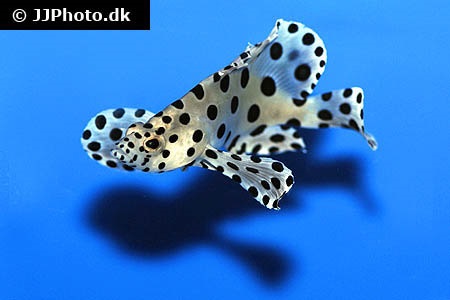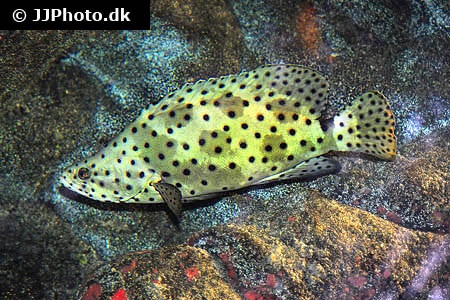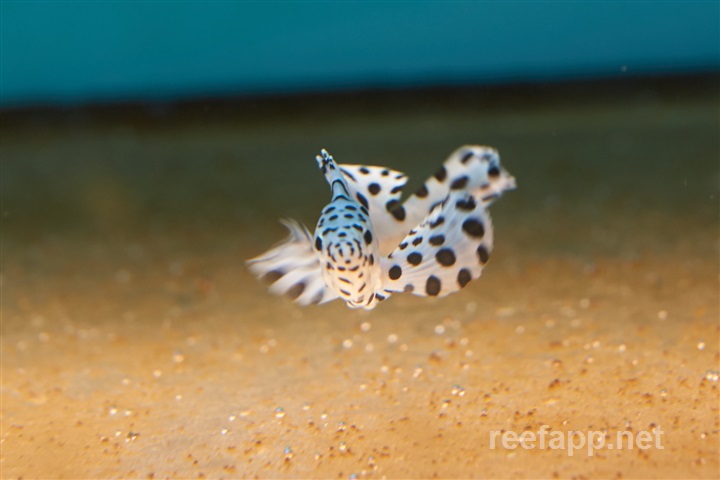Cromileptes altivelis
| Latin name | Cromileptes altivelis - (Valenciennes, 1828) |
|---|---|
| Local name | Humpback grouper |
| Family | Serranidae - Cromileptes |
| Origin | Australia, Indonesia |
| Max length | 70 cm (27.6") |
| Minimum volume |
2000 l (528 gal) |
|---|---|
| Hardiness |
Hardy |
| Suitable for aquarium |
Suitable with care |
| Reef safe |
Reef safe with caution |
| Aggressiveness | Peaceful |
| Recommended |
Fish Larger crustaceans (Shrimp, crabs...) Other invertebrates Small crustaceans (Krill, mysis, artemia...) |
|---|
This species grows very quickly if fed well.
This species eats all kinds of fish, shrimps, crabs etc. which are of suitable size.
This species needs a very large aquarium when fully grown.
Exactly how big the aquarium should be is hard to say, but the size of this species is such, that it cannot normally be kept in a home aquarium.
This species must be fed with an appropriately varied diet.
This species eats a great deal and demands an aquarium that can tolerate such a heavy load.
This species often has a fun and interesting personality.
This species needs good hiding places, for example, between live rocks.
This species can live with many of its own kind, when provided with enough space.
This species can be very shy when first introduced into a new aquarium.
More aggressive fish can be introduced after this species has acclimatized.
The Sea Bass family (Serranidae) spans a broad spectrum with regards to how suitable they are to aquaria, as some are best suited to specialist or larger aquaria, while other are often seen in reef aquaria.
Below are described the five subfamilies one sees most often in aquaria. There are however other species one can also keep under the right circumstances, but these are for the most, large predatory fish.
Anthias (Anthiinae)
The Anthias species spans over many different genera, but the most common is the Pseudanthias genus. They mostly have an attractive orange or pink shade.
They are generally all reef safe and peaceful.
There is however a large difference to their food requirements, some species demand constant feeding, whereas others can get used to being fed once a day.
The easiest species are the following: P. bartelettorum, Anthias, Luzonichthys, Nemanthias, Odontanthias, Pseudanthias, Sacura and Serranocirrhitus
Liopropomatinae
This subfamily encompasses some of the smallest fish in the Serranidae family, they can be very colourful but shy. The Liopropoma genus encompasses many species which are suitable for aquaria, however they normally thrive best in a very peaceful- or nano aquarium.
Grouper (Epinephelinae)
These fish grow typically too large for most home aquaria. There are however some species that do lend themselves to the slightly bigger domestic aquarium. Several of the species look very impressive and often have a interesting personality, and they often recognize the aquarist and will become tame over time.
Groupers are predatory fish and eat everything they can swallow; fish, crabs, shrimps and sometimes other invertebrates. Like most large predatory fish they excrete a lot of nutrients to the water, so one therefore needs a good filter system.
Groupers include among others the following genera: Aethaloperca, Cephalopholis, Chromileptes, Epinephelus, Paranthias and Pogonoperca
Soapfishes (Grammistinae)
These fish are like the Groupers predatory fish, but they do not typically, grow so large. They are relatively hardy, but some of the species demand a thorough preperation if one wants to be successful.
Soapfishes are generally very shy and will often hide under an overhang during the day, and hunt at night.
Soapfishes include among others the genera: Grammistes
Serraninae
The most common genera in captivity is Dwarf Seabasses (Serranus) and Hamlets (Hypoplectrus).
See the description of the individual genera below.
| Aquarium trade | Yes |
|---|---|
| Distribution | Western Pacific: southern Japan to Palau, Guam, New Caledonia and southern Queensland, Australia. Eastern Indian Ocean: Nicobar Islands to Broome, Western Australia. Reports from western Indian Ocean (Heemstra and Randall 1984, 1986, Ref. 3153 and 431 |
| English common names |
Humpback grouper Flatfish grouper Pantherfish Panther grouper Barramundi cod Baramundi cod Barrimundi cod |
| Danish common names |
Kamelbars |
| French common names |
Grisette |
| German common names |
Grace Kelly Zackenbarsch |
Scott W. Michael. 2001. Basslets, Dottybacks & Hawkfishes: v. 2 (Reef Fishes) TFH Publications / Microcosm Ltd. - (English)
Bob Fenner. The Basses, Family Serranidae - Wet Web Media - (English)




